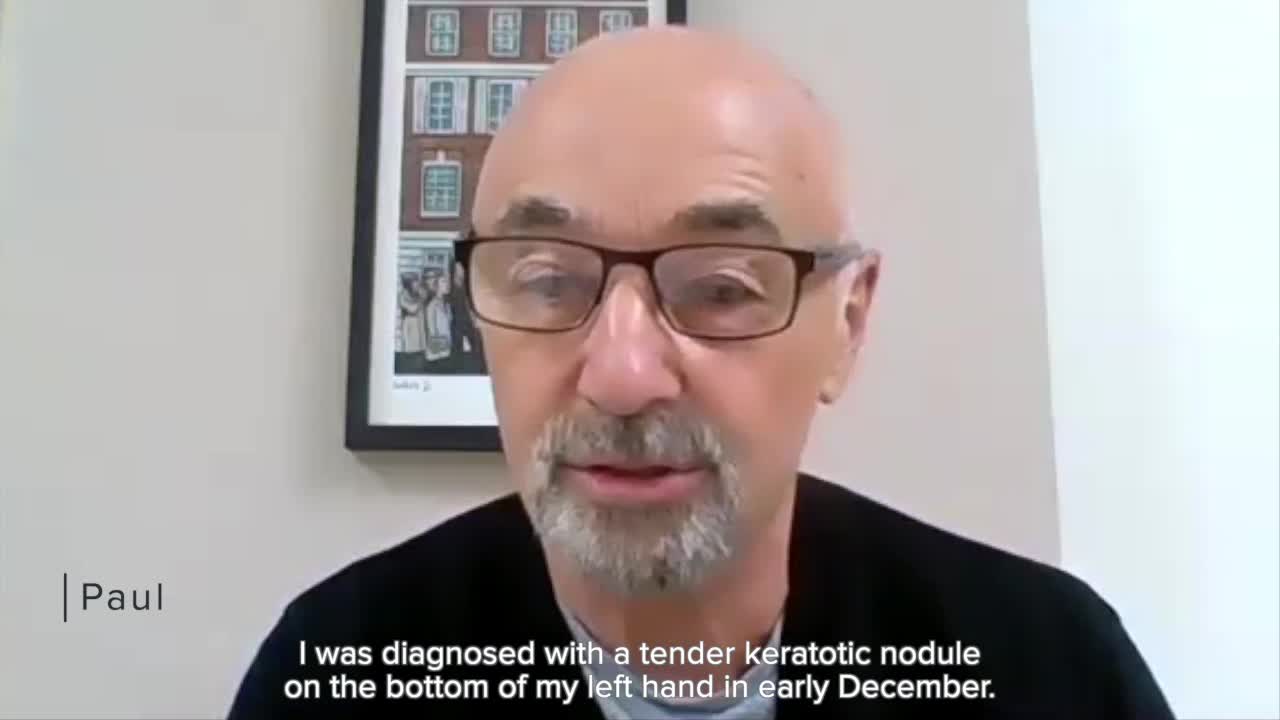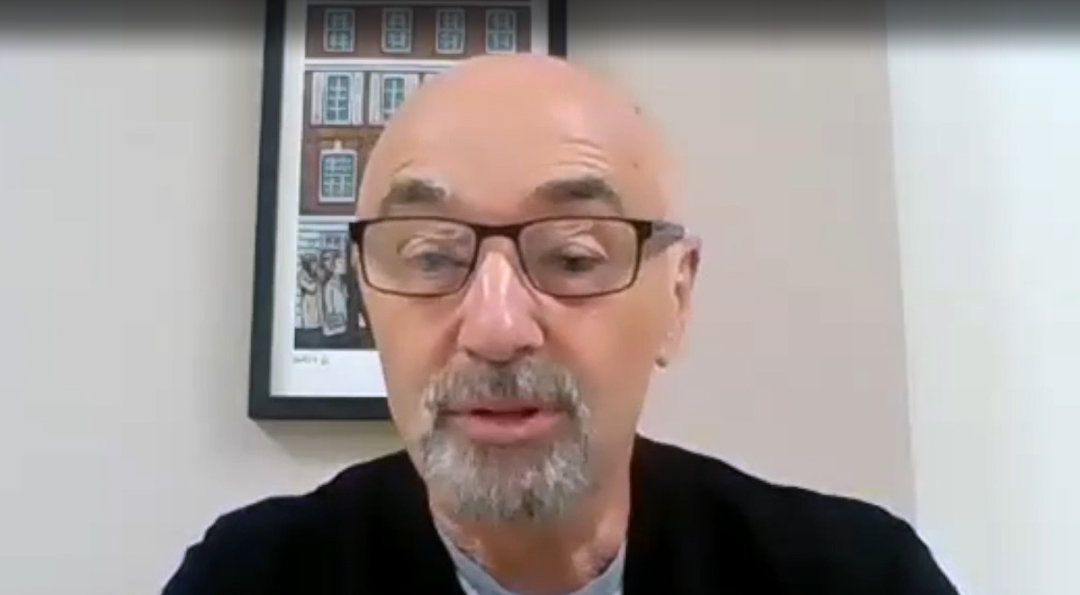
Brachytherapy for Skin Cancer: Paul's Experience
Real Stories
Paul
Paul talks about how brachytherapy quickly and efficiently treated a keratotic nodule on his hand.

If you or a loved one has been diagnosed with skin cancer, you may be wondering what your treatment options are. Surgery is often the first choice, but it is not always possible, especially for cancers located in sensitive areas like the face or hands. Fortunately, there is an innovative treatment option; brachytherapy, which is proving to be highly effective in treating various types of skin cancer.
What is Skin Cancer?
Skin cancer is a disease that occurs when abnormal cells grow uncontrollably in the skin. It is the most common form of cancer in the United States, with over one million cases diagnosed each year. There are two main types of skin cancer: melanoma and non-melanoma. Melanoma is a more aggressive form of skin cancer and can spread quickly to other parts of the body. Non-melanoma skin cancer includes basal cell carcinoma and squamous cell carcinoma, which are less aggressive but still require prompt treatment.
What are the common skin cancer symptoms?
Skin cancers can manifest in various ways, and it's important to be aware of the signs and symptoms so that you can seek prompt medical attention if you suspect that you may have skin cancer. Here are some common symptoms of skin cancer:
- Changes in the appearance of a mole: A mole that changes in size, shape, color, or texture may be a sign of skin cancer.
- New growths on the skin: Skin cancer may appear as a new growth or bump on the skin that is hard, scaly, or crusty.
- Sores that don't heal: Skin cancer may appear as a sore that doesn't heal, or a sore that heals and then returns.
- Redness or inflammation: Skin cancer may cause redness or inflammation on the skin, which may be accompanied by pain or tenderness.
- Itching or bleeding: Skin cancer may cause itching or bleeding on the skin, especially around moles or other areas that are frequently exposed to the sun.
- Sun sensitivity: People with skin cancer may experience increased sensitivity to the sun, with a tendency to burn easily and quickly.
What factors increase the risk of being diagnosed with skin cancer?
Skin cancer is primarily caused by exposure to ultraviolet (UV) radiation from the sun or other sources such as tanning beds. UV radiation damages the DNA in skin cells, leading to mutations that can develop skin cancer.
Some factors that increase the risk of developing most skin cancers include:
- Excessive sun exposure: Spending time in the sun without protection, especially during peak hours between 10 a.m. and 4 p.m., increases the risk of developing skin cancer. The sun-exposed areas are more likely to cause skin cancer.
- Tanning beds: The use of tanning beds and sun lamps can increase the risk of skin cancer, especially if used frequently or for long periods.
- Skin type: People with fair skin, blonde or red hair, and blue or green eyes are at a higher risk of developing skin cancer.
- Family history: Skin cancer can run in families, and people with a family history of the disease may be at a higher risk.
- Age: The risk of skin cancer increases with age, with the majority of cases occurring in people over the age of 50.
- Immune system suppression: People with weakened immune systems, such as those with HIV/AIDS or who have had an organ transplant, are at a higher risk of developing skin cancer.
It's important to take steps to reduce your risk of developing skin cancers, such as wearing protective clothing and using sunscreen when outdoors, avoiding tanning beds, and regularly checking your skin for any changes or abnormalities. If you suspect skin cancer, then contact a doctor as soon as possible.
Why Choose Brachytherapy for Skin Cancer Treatment?
Brachytherapy is a technique that has been proven to be highly effective in treating various types of skin cancers, including keratotic nodules. It is a quick, efficient, and minimally invasive treatment option that delivers excellent cosmetic and functional results, with minimal side effects. The personalized moulds and applicators used in the treatment are designed to fit the patient's unique anatomy, ensuring that the radiation is delivered precisely to the target area.
Brachytherapy is a treatment option for non-melanoma skin cancer that is becoming increasingly popular due to its many advantages over traditional radiation therapy and surgery. This innovative technique delivers radiation materials inside the body, in or as close as possible to the tumor, to destroy cancer cells while sparing healthy tissue from harmful radiation exposure.
The Advantages of Brachytherapy for Skin Cancer Treatment
Brachytherapy for skin cancers offers many advantages over traditional radiation therapy and surgery, including:
- Excellent cosmetic and functional outcomes
- Minimal side effects
- Quick recovery time
- Precise delivery of radiation to the target area
- Minimized damage to healthy tissue
- Minimized damage to your immune system
Despite its many advantages, brachytherapy is still a relatively unknown treatment option for skin cancer. Patients like Paul play an essential role in spreading awareness about this innovative technique and encouraging others to consider it as part of their treatment plan. By sharing their experiences and success stories, they can help dispel the misconceptions and fears that often surround cancer treatments.
Paul's Experience with Brachytherapy for Skin Cancer Treatment
Paul received a skin cancer diagnosis for a keratotic nodule on the back of his left hand, a type of non-melanoma skin cancer. After consulting with his doctor, he learned about brachytherapy, an option for his treatment. He benefited from a technique called superficial brachytherapy, a non-invasive and painless procedure. The personalized moulds and applicators used in the treatment were designed to fit his hand anatomy, ensuring that the radiation was delivered precisely to the target area.

In January, Paul went to Christie Hospital, one of the largest cancer centers in Europe, for eight treatments, twice a day over four days. Each session lasted 15-20 minutes, and the radiation was delivered through the mold attached to his hand. Paul shared how convenient the procedure was. Brachytherapy for skin cancer is an innovative treatment option that is becoming increasingly popular due to its many advantages over traditional radiation therapy and surgery. Patients who have undergone this treatment have reported excellent cosmetic and functional outcomes, minimal side effects, quick recovery times, and precise delivery of radiation to the target area.
A happy patient who recommends brachytherapy
Today, Paul is a happy patient who wants to share his experience of brachytherapy with anyone considering it as part of their treatment plan. In his testimony, he enthusiastically states: “Brachytherapy certainly fixed the issue I had on the back of my hand. I am now 6 months on and I have got no side effects or issues.” He reiterates how delighted he is with the treatment he has received, from start to finish. He is astounded by how quickly the process has gone. Considering he had undergone a previous cancer treatment on his neck, he remains amazed by the absence of side effects and eagerly testifies of the incredible outcomes of the procedure - no aftermaths whatsoever.
His last words are toward worried patients. With genuine positivism and a smile on his face, Paul reassures them and advises them not to worry: ”stay positive, live life as you want, and think brachytherapy!” He ends by proudly showing the back of his hand, adding: “[brachytherapy] certainly fixed me and I have had no issues with it whatsoever afterward.”
FAQs
Is Brachytherapy Painful?
No, brachytherapy is a non-invasive, painless procedure that typically involves minimal discomfort and side effects. The personalized moulds and applicators used in the treatment are designed to fit the patient's unique anatomy, ensuring that the radiation is delivered precisely to the target area, without causing any pain.
How Long Does Brachytherapy Treatment Last?
The length of brachytherapy treatment can vary depending on the type and stage of cancer being treated, but typically lasts for several days to several weeks. In Paul's case, he received eight treatments, twice a day over four days, each session lasting 15-20 minutes.
Can Brachytherapy Be Used to Treat Other Types of Cancer?
Yes, brachytherapy is a versatile treatment option that can be used to treat various types of cancer, including prostate, breast and gynecological cancers.
How effective is brachytherapy for treating skin cancer?
Brachytherapy has been shown to be highly effective in treating various types of skin cancer, with cure rates comparable to surgical excision. Studies have shown excellent cosmetic and functional outcomes, with minimal side effects.
What are the potential side effects of brachytherapy for skin cancer?
The side effects of brachytherapy for skin cancer are generally mild and temporary. Patients may experience redness, itching, or scabbing at the treatment site, but these side effects typically resolve within a few weeks.
Can brachytherapy be used to treat melanoma?
Brachytherapy is not typically used to treat melanoma, as this form of skin cancer is more aggressive and may require more aggressive treatment options such as surgery or systemic therapy. However, in some cases, brachytherapy may be used as adjuvant therapy following surgery.
How is the brachytherapy applicator removed after treatment?
The brachytherapy applicator is typically removed by a healthcare provider in the clinic or hospital where the treatment was administered. The removal process is generally quick and painless, and patients can resume their normal activities shortly after.
